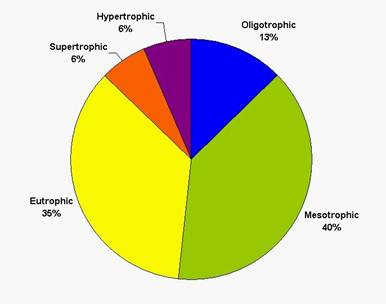Water Quality
Within this section…
In 2005, NRC established the Lakes Water Quality Monitoring Network. Under this programme, water quality samples are taken from 31 of the region's lakes every quarter and analysed for a range of properties. Lakes in this network include those in the Kai Iwi, Aupouri, Central/Karikari and Pouto lakes groups.
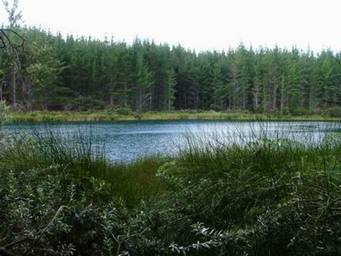
Photo: Lake Te Kahika in the Aupouri Lakes group
Parameters tested include water clarity, chlorophyll a, temperature, dissolved oxygen, pH, suspended solids, total phosphorus, total nitrogen, dissolved reactive phosphorus, organic phosphorus, nitrate nitrogen, ammoniacal nitrogen and organic nitrogen. Both temperature and dissolved oxygen are used to test whether or not a lake is stratified. Stratification occurs when cold water at the bottom and warm water at the top of a lake form layers that act as a barrier to mixing in the water body.
The state of a lake can be determined using the Trophic Level Index (TLI). The TLI is calculated using four key variables - chlorophyll a (an indicator of algal biomass), water clarity (measured by lowering a Secchi disc into water and measuring the depth at which it disappears), total nitrogen and total phosphorus (both a measure of nutrient enrichment). Together, these provide an indication of a lake's overall health.
Table 1 (below) shows the values that define the different trophic levels (Burns et al. 2000). Following this, results are given for each lake from the 2007-08 survey season.
| Lake type | Trophic level | Chlα (mg/m3) | Clarity (m) | TP (mg/m3) | TN (mg/m3) |
| Ultra-microtrophic | 0.0 - 1.0 | 0.13 - 0.33 | 33 - 25 | 0.84 - 1.8 | 16 - 34 |
| Microtrophic | 1.0 - 2.0 | 0.33 - 0.82 | 25 - 15 | 1.8 – 4.1 | 34 - 73 |
| Oligotrophic | 2.0 - 3.0 | 0.82 - 2.0 | 15 - 7.0 | 4.1 – 9.0 | 73 - 157 |
| Mesotrophic | 3.0 - 4.0 | 2.0 - 5.0 | 7.0 - 2.8 | 9.0 - 20 | 157 - 337 |
| Eutrophic | 4.0 - 5.0 | 5.0 - 12 | 2.8 - 1.1 | 20 - 43 | 337 - 725 |
| Supertrophic | 5.0 - 6.0 | 12 - 31 | 1.1 - 0.4 | 43 - 96 | 725 - 1558 |
| Hypertrophic | 6.0 - 7.0 | > 31 | < 0.4 | > 96 | > 1558 |
Table 1: Values of variables that define the boundaries of different trophic levels.
Aupouri Lakes
Lake Carrot
Lake Carrot is one of the Sweetwater dune lakes. The catchment is dominated by pasture, with forestry on the northern side of the lake. The 2007-08 results are summarised in the table below.
| Parameter | Range |
| Temperature (°C) | 12.4 - 24.7 |
| Dissolved Oxygen (mg/L) | 6.4 - 9.6 |
| Dissolved Oxygen (% sat.) | 70.3 - 90 |
| Chlorophyll a (mg/L) | 3 - 14.5 |
| Conductivity (mSm) | 15.8 - 19.1 |
| Water clarity (m) | 1.9 - 3.08 |
| Dissolved reactive phosphorus (mg/L) | <1 - 1 |
| Total phosphorus (mg/L) | 20 - 41 |
| Ammoniacal nitrogen (mg/L) | 8 - 32 |
| Total nitrogen (mg/L) | 595 - 801 |
| PH | 6 - 7.21 |
Summer thermal stratification was observed with deoxygenation (0.2 mg/m³) of bottom water with slightly higher concentrations of total phosphorus (TP 41 mg/m³) and slightly lower total nitrogen levels (669 mg/m³) in relation to the upper water column (TP 28 mg/m³; TN 801 mg/m³).
The graph below shows that most parameters fall in or slightly above the eutrophic range. There was a drop in the chlorophyll a over the last two sampling events. The average TLI score for the past year was 4.55 indicating a eutrophic status.
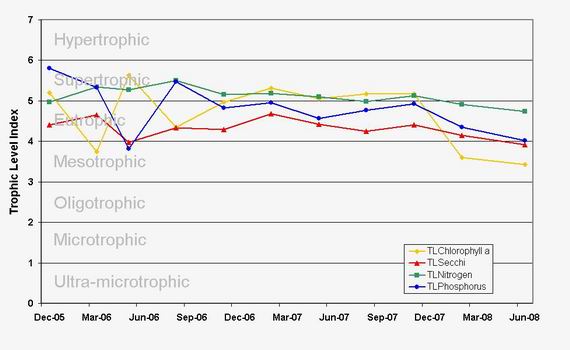
Figure 1: Lake Carrot TLI for chlorophyll a, secchi, total nitrogen, and total phosphorus from December 2005 to July 2008.
Lake Heather
This dune lake is also one of the Sweetwater lakes and is surrounded by pasture. This lake is entirely fenced with riparian planting. The table below summarises the 2007-08 results for Lake Heather.
| Parameter | Range | |
| Temperature (°C) | 12.5 - 25 | |
| Dissolved Oxygen (mg/L) | 8 - 10.3 | |
| Dissolved Oxygen (% sat.) | 88 - 97.3 | |
| Chlorophyll a (mg/L) | 2.3 - 6.7 | |
| Conductivity (mSm) | 17.3 - 19.7 | |
| Water clarity (m) | 3 - 4.2 | |
| Dissolved reactive phosphorus (mg/L) | <1 - 1 | |
| Total phosphorus (mg/L) | 11 - 16 | |
| Ammoniacal nitrogen (mg/L) | <1 - 5 | |
| Total nitrogen (mg/L) | 292 - 856 | |
| PH | 6.7 - 7.25 | |
Summer stratification was not observed this year. The TLI score for the four key parameters has generally fallen in the mesotrophic range between 3 and 4 over the past three years. However, there was a rise in total phosphorus in March 2006 then a fall two months later. The average TLI score for all parameters for the past year was 3.79, which indicates a mesotrophic status.
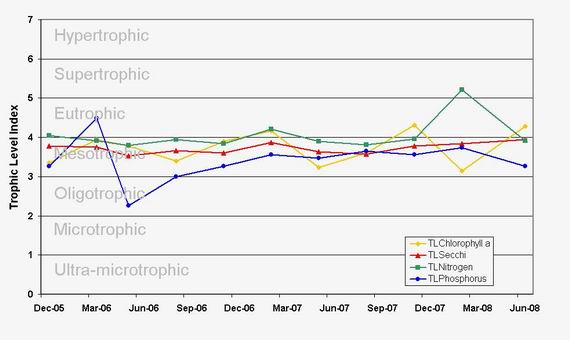
Figure 2: Lake Heather TLI for chlorophyll a, secchi, total nitrogen, and total phosphorus from December 2005 to July 2008.
Lake Morehurehu
Lake Morehurehu is a large dune lake that is situated in a catchment dominated by pine forest. This lake is predominantly fed by rainfall however there are three small streams that flow into the lake. Results for 2007-08 are given below.
| Parameter | Range |
| Temperature (°C) | 14 - 25 |
| Dissolved Oxygen (mg/L) | 6.8 - 9.6 |
| Dissolved Oxygen (% sat.) | 75.3 - 100.4 |
| Conductivity (mSm) | 29.9 - 31.7 |
| Water clarity (m) | 1.94 - 3.4 |
| Dissolved reactive phosphorus (mg/L) | <1 - 1 |
| Total phosphorus (mg/L) | 5 - 18 |
| Ammoniacal nitrogen (mg/L) | 5.0 - 10 |
| Total nitrogen (mg/L) | 324 - 385 |
| PH | 6 - 6.8 |
The lake was stratified when sampled in January, with moderate deoxygenation (0.9 mg/m³) of bottom water and higher concentrations of nutrients (TN 629 mg/m³; TP 28 mg/m³) compared to the upper water column (TN 335 mg/m³, TP 18 mg/m³).
TLI score for total nitrogen has been very similar over the last two years of monitoring (shown in the graph below). Total phosphorus has varied the most out of the four main parameters. The average TLI for the past year is 3.68, which indicates a mesotrophic status.
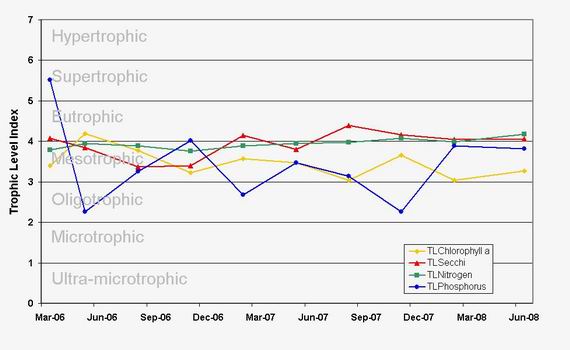
Figure 3: Lake Morehurehu TLI for chlorophyll a, secchi, total nitrogen, and total phosphorus from March 2006 to July 2008.
Lake Ngakapua
Lake Ngakapua comprises two basins that are separated by a dense reed-bed and small island. Surrounding land-use is predominantly pasture with some pines on the western edge of the north basin. The north basin and part of the south basin has recently been fenced to exclude stock.
North Basin
Results for 2007-08 are summarised in the table below.
| Parameter | Range |
| Temperature (°C) | 12.8 - 24.7 |
| Dissolved Oxygen (mg/L) | 6.7 - 9.1 |
| Dissolved Oxygen (% sat.) | 71.8 - 90.2 |
| Chlorophyll a (mg/L) | 1.7 - 15.2 |
| Conductivity (mSm) | 15.4 - 17.5 |
| Water clarity (m) | 2.9 - 6.04 |
| Dissolved reactive phosphorus (mg/L) | <1 |
| Total phosphorus (mg/L) | 10.0 - 58 |
| Ammoniacal nitrogen (mg/L) | 2 - 5.0 |
| Total nitrogen (mg/L) | 425 - 522 |
| PH | 5.9 - 7.34 |
The lake was stratified in November, with deoxygenation (0.3 mg/m³) of bottom water and lower levels of nutrients (TN 434 mg/m³; TP 13 mg/m³) in relation to the upper water column (TN 522 mg/m³; TP 58 mg/m³).
TLI score for total nitrogen has remained in the eutrophic category. In November 2007, there was a slight algal bloom dominated by non toxic dinoflagellates, which explains the chlorophyll a peak. Water clarity measurements have mostly been in the mesotrophic range.
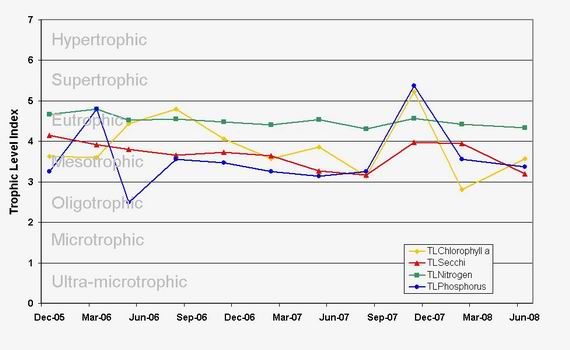
Figure 4: Lake Ngakapua (North basin) TLI for chlorophyll a, secchi, total nitrogen, and total phosphorus from December 2005 to July 2008.
South Basin
Results for 2007-08 are summarised in the table below.
| Parameter | Range |
| Temperature (°C) | 12.2 - 24.7 |
| Dissolved Oxygen (mg/L) | 6.9 - 9.7 |
| Dissolved Oxygen (% sat.) | 78.3 - 89.9 |
| Chlorophyll a | 1.9 - 12.1 |
| Conductivity (mSm) | 15.1 – 18 |
| Water clarity (m) | 3 - 4.8 |
| Dissolved reactive phosphorus (mg/L) | <1 |
| Total phosphorus (mg/L) | 15 – 20 |
| Ammoniacal nitrogen (mg/L) | 3 – 13 |
| Total nitrogen (mg/L) | 466 – 577 |
| PH | 6 - 7.28 |
Stratification was observed in November with deoxygenation of bottom water (0.4 mg/m³). Nutrient concentrations for bottom and surface waters were very similar (TN 503 mg/m³ and TP 16 mg/m³ bottom water; TN 547 mg/m³ and TP 19 mg/m³ surface water).
Total nitrogen and secchi results have been consistent over the last three years of monitoring. Total nitrogen results have remained in the eutrophic range for 10 out of 11 sampling events. Secchi results have all been in the mesotrophic range. The average TLI score for all parameters for the past year was 4.04, which indicates a eutrophic status.
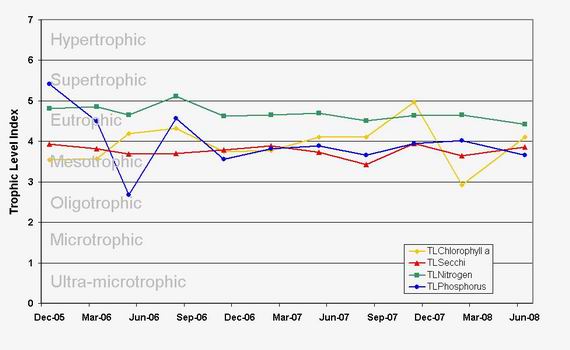
Figure 5: Lake Ngakapua (South basin) TLI for chlorophyll a, secchi, total nitrogen, and total phosphorus from December 2005 to July 2008.
Lake Ngakeketa North
This dune lake was formed when mobile sand dunes impounded a stream and as the dune continues to move, the lake level continues to rise. The immediate catchment is native scrub, which is completely fenced, with grazed pasture in the upper catchment. The results from 2007-08 are summarised in the table below.
| Parameter | Range |
| Temperature (°C) | 14.1 - 19.8 |
| Dissolved Oxygen (mg/L) | 7.8 - 9.1 |
| Dissolved Oxygen (% sat.) | 84.8 - 99.7 |
| Chlorophyll a | 19.1 - 28.7 |
| Conductivity (mSm) | 21.2 - 21.8 |
| Water clarity (m) | 1.7 - 2.05 |
| Dissolved reactive phosphorus (mg/L) | < 1 - 1 |
| Total phosphorus (mg/L) | 17 - 24 |
| Ammoniacal nitrogen (mg/L) | 1 - 3 |
| Total nitrogen (mg/L) | 302 - 400 |
| PH | 6.73 - 7.1 |
Lake Ngakeketa North is often stratified for long periods of time (November to May) as it is relatively deep (>17m) and sheltered. Stratification was observed in May and November with deoxygenation of bottom water (0.3 – 0.9 mg/m³). In May, total nitrogen concentrations were higher in the bottom water compared to the surface water (995 and 302 mg/m³, respectively).
The TLI score for chlorophyll a is continuously higher than the other three parameters, usually falling in the supertrophic range. This indicates a high algal biomass however very low levels of toxic algae have been observed. In March 2006, a peak in total phosphorus levels was observed with a rapid drop three months later. This may be related to mixing of the lake in May however there is limited data to confirm this. Annual average TLI score is 4.53 indicating a eutrophic status.
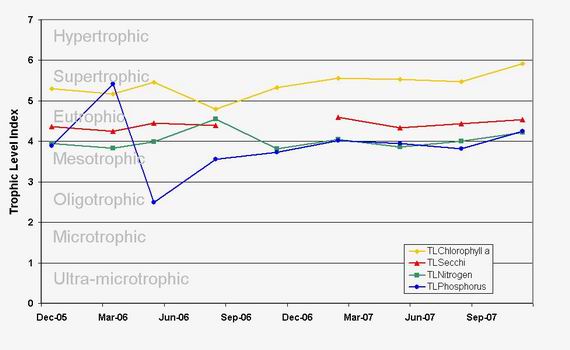
Figure 6. Lake Ngakeketa North TLI for chlorophyll a, secchi, total nitrogen, and total phosphorus from December 2005 to November 2007.
Lake Ngatu
Lake Ngatu is part of the Sweetwater dune lake system and is surrounded by native scrub, with some fenced pasture and housing on the northern edge of the lake. The table below summarises the results from 2007-08.
| Parameter | Range |
| Temperature (°C) | 12.6 - 25.3 |
| Dissolved Oxygen (mg/L) | 7.6 - 10 |
| Dissolved Oxygen (% sat.) | 76 - 94.6 |
| Chlorophyll a | 1.7 - 2.3 |
| Conductivity (mSm) | 17.4 - 20.5 |
| Water clarity (m) | 3.93 - 5.6 |
| Dissolved reactive phosphorus (mg/L) | <1 |
| Total phosphorus (mg/L) | 9 - 28 |
| Ammoniacal nitrogen (mg/L) | 95 - 365 |
| Total nitrogen (mg/L) | 542 - 990 |
| PH | 6.4 - 7.04 |
Thermal stratification has not been detected in this lake. Secchi measurements have been consistent over the last three years and have remained in the mesotrophic range. Total nitrogen has always been a class or two higher than the other parameters and suggests that total phosphorus is limited. Again there was a peak in total phosphorus levels in March 2006 then a drop three months later. The average TLI score for all parameters for the past year was 3.7, which indicates a mesotrophic status.
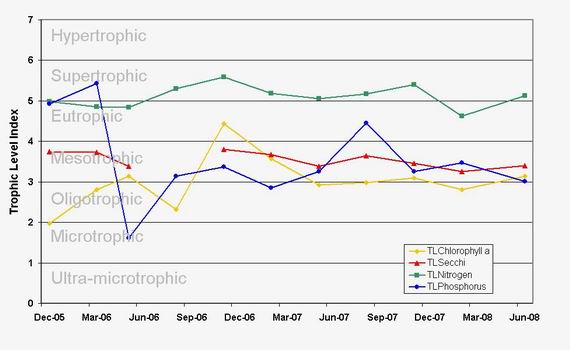
Figure 7: Lake Ngatu TLI for chlorophyll a, secchi, total nitrogen, and total phosphorus from December 2005 to July 2008.
Lake Rotokawau
This Sweetwater dune lake is situated in a pastoral dominated catchment and is completely fenced. Riparian planting has been undertaken on the western side of the lake. Results for 2007-08 are summarised in the table below.
| Parameter | Range |
| Temperature (°C) | 12.1 - 25.1 |
| Dissolved Oxygen (mg/L) | 6.8 - 10 |
| Dissolved Oxygen (% sat.) | 75.6 - 93.1 |
| Chlorophyll a | 0.8 - 2.4 |
| Conductivity (mSm) | 13 - 16.6 |
| Water clarity (m) | 2.1 - 3.4 |
| Dissolved reactive phosphorus (mg/L) | <1 - 1 |
| Total phosphorus (mg/L) | 9 - 39 |
| Ammoniacal nitrogen (mg/L) | <1 - 19 |
| Total nitrogen (mg/L) | 414 - 8.8 |
| PH | 6.4 - 6.89 |
Thermal stratification has not been detected in this lake. The only parameter that has been consistent over the last three years is the secchi measurements. Chlorophyll a and total phosphorus results have varied over three and four classes, respectively. Average TLI score for the last year was 3.75 indicating a mesotrophic status.
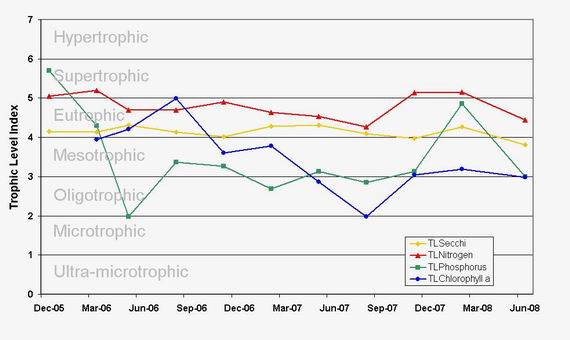
Figure 8: Lake Rotokawau trophic level scores for chlorophyll a, secchi, total nitrogen, and total phosphorus from December 2005 to July 2008.
Lake Rotoroa
Lake Rotoroa is also part of the Sweetwater dune lake system. The catchment is predominantly pasture, with much of the lake fenced and planted. The table below summarises the results for 2007-08.
| Parameter | Range |
| Temperature (°C) | 12.2 - 25.5 |
| Dissolved Oxygen (mg/L) | 8.5 - 10.5 |
| Dissolved Oxygen (% sat.) | 95.6 - 104.2 |
| Chlorophyll a | 7.3 - 27.6 |
| Conductivity (mSm) | 26.3 - 29.9 |
| Water clarity (m) | 1.18 - 2.75 |
| Dissolved reactive phosphorus (mg/L) | <1 - 2 |
| Total phosphorus (mg/L) | 13 - 95 |
| Ammoniacal nitrogen (mg/L) | 1 - 9 |
| Total nitrogen (mg/L) | 639 - 875 |
| PH | 6.3 - 7.14 |
The lake was stratified in November 2007 and January 2008 with deoxygenation of bottom water (0.4 – 0.7 mg/m³) and higher total nitrogen concentrations (TN 825 - 1020 mg/m³) compared to the surface (TN 790 – 794 mg/m³).
Chlorophyll a levels have increased over the last three years from an oligotrophic to supertrophic score (refer to graph x). There have been two peaks in total phosphorus levels, one in December 2005 and one in September 2007. The trophic score for total nitrogen has been similar over the past three years and has a score ranging from 4.6 – 5.1. Annual average TLI score was 4.78 indicating a eutrophic status.
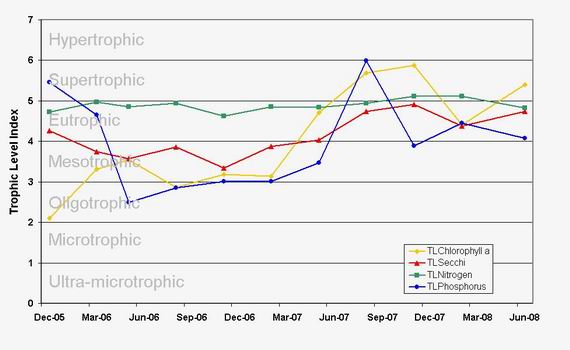
Figure 9: Lake Rotoroa TLI for chlorophyll a, secchi, total nitrogen, and total phosphorus from December 2005 to July 2008.
Lake Te Kahika
This lake is situated in a forestry dominated catchment, surrounded by manuka scrub. There are two small streams that feed the lake and one outlet that flows towards Great Exhibition Bay. Results from 2007-08 are summarised in the table below.
| Parameter | Range |
| Temperature (°C) | 13.5 - 24.6 |
| Dissolved Oxygen (mg/L) | 7.3 - 9.9 |
| Dissolved Oxygen (% sat.) | 79.9 - 97.7 |
| Chlorophyll a | 0.2 - 1.4 |
| Conductivity (mSm) | 58.5 - 71.6 |
| Water clarity (m) | 1.06 - 10 |
| Dissolved reactive phosphorus (mg/L) | <1 |
| Total phosphorus (mg/L) | 2 - 7 |
| Ammoniacal nitrogen (mg/L) | 4 - 92 |
| Total nitrogen (mg/L) | 138 - 448 |
| PH | 3.6 - 3.99 |
Thermal stratification was detected over summer with deoxygenation of bottom water (0.4 mg/m³) and higher total nitrogen concentrations (TN 934 mg/m³) compared to the surface (TN 138 mg/m³).
This lake has very unusual water chemistry and has a pH around 4, which is very acidic. This may help to explain why the results for each parameter are so highly variable. It is rare for a parameter to be similar on two consecutive sampling events. Total phosphorus results are very low and are generally in the oligotrophic or microtrophic range. Annual average TLI is 2.7 indicating an oligotrophic status.
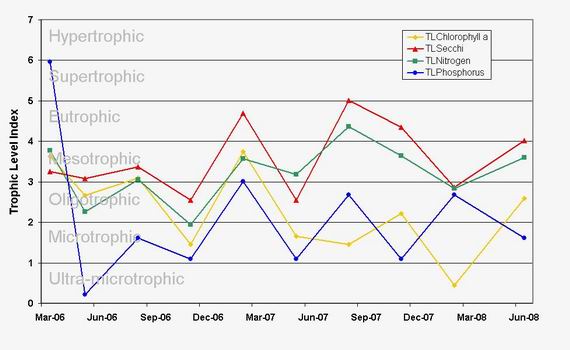
Figure 10: Lake Te Kahika TLI for chlorophyll a, secchi, total nitrogen, and total phosphorus from March 2006 to July 2008.
Lake Te Paki Dune
This small dune lake is situated between mobile dunes and native scrub. The results for 2007-08 are summarised below.
| Parameter | Range |
| Temperature (°C) | 13 - 19.1 |
| Dissolved Oxygen (mg/L) | 6.2 - 9 |
| Dissolved Oxygen (% sat.) | 66 - 85.4 |
| Chlorophyll a | 1.9 - 2.4 |
| Conductivity (mSm) | 15.2 - 18.5 |
| Water clarity (m) | 2.12 - 3 |
| Dissolved reactive phosphorus (mg/L) | <1 - 4 |
| Total phosphorus (mg/L) | 9 - 11 |
| Ammoniacal nitrogen (mg/L) | <1 - 5 |
| Total nitrogen (mg/L) | 236 - 244 |
| PH | 6.6 - 7 |
Thermal stratification has not been detected in this shallow lake. TLI scores for the four key parameters are consistent since monitoring began in August 2006. The average TLI score for the past year is 3.5 indicating a mesotrophic status.
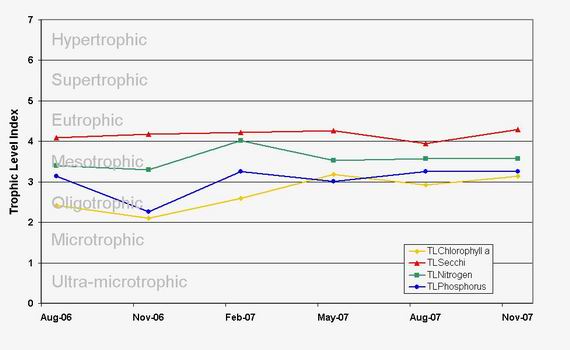
Figure 11: Lake Te Paki dune TLI for chlorophyll a, secchi, total nitrogen, and total phosphorus from August 2006 to November 2007.
Lake Waihopo
The catchment of this lake is dominated by pasture. The edges of the lake are fenced to exclude livestock. The table below summaries the results for 2007-08.
| Parameter | Range |
| Temperature (°C) | 12.9 - 26.3 |
| Dissolved Oxygen (mg/L) | 6.2 - 9.7 |
| Dissolved Oxygen (% sat.) | 72.2 - 101.2 |
| Chlorophyll a | 1.6 - 13.1 |
| Conductivity (mSm) | 19 - 23.7 |
| Water clarity (m) | 1.8 - 2.85 |
| Dissolved reactive phosphorus (mg/L) | <1 - 1 |
| Total phosphorus (mg/L) | 19 - 26 |
| Ammoniacal nitrogen (mg/L) | 5 - 47 |
| Total nitrogen (mg/L) | 569 - 675 |
| PH | 6.2 - 6.87 |
Thermal stratification has not been detected in this lake. TLI scores for clarity and total nitrogen have been consistent since December 2005 (refer to graph below). There has been some variation in chlorophyll a and total phosphorus. Annual average TLI score for Lake Waihopo is 4.19 indicating a eutrophic status.
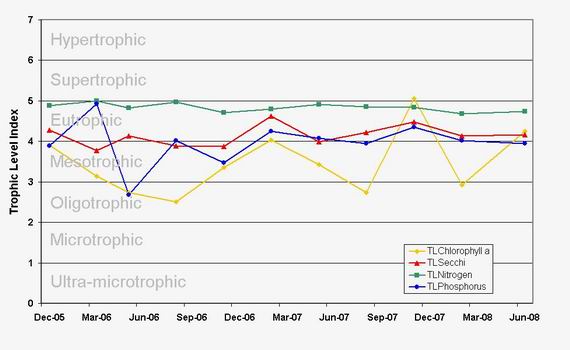
Figure 12: Lake Waihopo TLI for chlorophyll a, secchi, total nitrogen, and total phosphorus from December 2005 to July 2008.
Lake Waipara
This lake is situated in a forestry dominated catchment and has no inflow or outflow streams. Results for 2007-08 are summarised in the table below.
| Parameter | Range |
| Temperature (°C) | 13 - 25.5 |
| Dissolved Oxygen (mg/L) | 6.8 - 8.6 |
| Dissolved Oxygen (% sat.) | 74.3 - 91.3 |
| Chlorophyll a | 1.3 - 12.9 |
| Conductivity (mSm) | 14.5 - 16.5 |
| Water clarity (m) | 3 - 4.7 |
| Dissolved reactive phosphorus (mg/L) | <1 - 1 |
| Total phosphorus (mg/L) | 9 - 36 |
| Ammoniacal nitrogen (mg/L) | 3 - 34 |
| Total nitrogen (mg/L) | 331 - 626 |
| PH | 5.6 - 6.8 |
Thermal stratification was recorded in January this year, with deoxygenation (0.6 mg/m³) of bottom water and higher total nitrogen concentrations (671 mg/m³) compared to the upper water column (552 mg/m³). TLI scores for secchi have remained in the mesotrophic range. TLI scores for chlorophyll a have however varied between the mesotrophic and supertrophic range over the last few years. Annual average TLI score was 3.88 indicating a mesotrophic status.
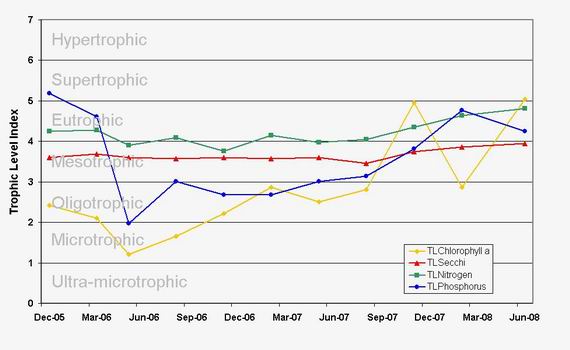
Figure 13: Lake Waipara TLI for chlorophyll a, secchi, total nitrogen, and total phosphorus from December 2005 to July 2008.
Lake Waiparera
Lake Waiparera is the largest of the Aupouri lakes but is relatively shallow (maximum depth 6m). Two thirds of its catchment is pasture, with the remainder in native scrub or wetland. There are several small inflows however there is no outflow. The results from 2007-08 are summarised below.
| Parameter | Range |
| Temperature (°C) | 12.4 - 19 |
| Dissolved Oxygen (mg/L) | 8.5 - 9.7 |
| Dissolved Oxygen (% sat.) | 89.7 - 95.5 |
| Chlorophyll a | 7 - 16.7 |
| Conductivity (mSm) | 23.8 - 27.9 |
| Water clarity (m) | 1.7 - 3.21 |
| Dissolved reactive phosphorus (mg/L) | <1 - 2 |
| Total phosphorus (mg/L) | 19 - 36 |
| Ammoniacal nitrogen (mg/L) | 1 - 45 |
| Total nitrogen (mg/L) | 741 - 1180 |
| PH | 6.8 - 7.22 |
Stratification has not been observed in this lake. Secchi and total nitrogen are the two parameters that have remained consistent over the two and a half years of monitoring (refer to graph below). TLI score for the past year was 4.71 indicating a eutrophic status.
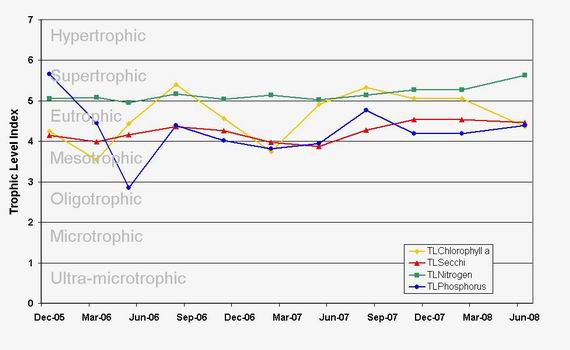
Figure 14: Lake Waiparera TLI for chlorophyll a, secchi, total nitrogen, and total phosphorus from December 2005 to July 2008.
Karikari and Central Lakes
Lake Omapere
Lake Omapere is the largest lake in Northland, being 1197 hectares in area but only two meters at its deepest. The surrounding catchment is mainly pasture with a few areas of native scrub and mature bush. There are a number of small streams flowing into the lake and one large outlet, which feeds the Utakura River. Results from 2007-08 are summarised in the table below.
| Parameter | Range | |
| Eastern site | Western site | |
| Temperature (°C) | 9.2 - 20.3 | 9.2 - 20.6 |
| Dissolved Oxygen (mg/L) | 8.2 - 10.4 | 8.3 - 10.4 |
| Dissolved Oxygen (% sat.) | 74.1 - 98.4 | 76.2 - 98.6 |
| Chlorophyll a | 5.2 - 53 | 6 - 66 |
| Conductivity (mSm) | 6.2 - 7.5 | 5 - 7.4 |
| Water clarity (m) | 0.28 - 0.4 | 0.17 - 0.4 |
| Dissolved reactive phosphorus (mg/L) | <4 - 128 | na |
| Total phosphorus (mg/L) | 70 - 348 | 54 - 241 |
| Ammoniacal nitrogen (mg/L) | <10 - 50 | na |
| Total nitrogen (mg/L) | 840 - 1390 | 200 - 2930 |
| PH | 6 - 7.4 | 5.8 - 7.2 |
NRC monitors two areas of the lake, one in the east and one in the west. The results for each site show similar trends in TLI scores for the four key parameters. Annual average TLI was 5.95 for the eastern site and 5.88 for the western site. Both scores indicate a supertrophic status.
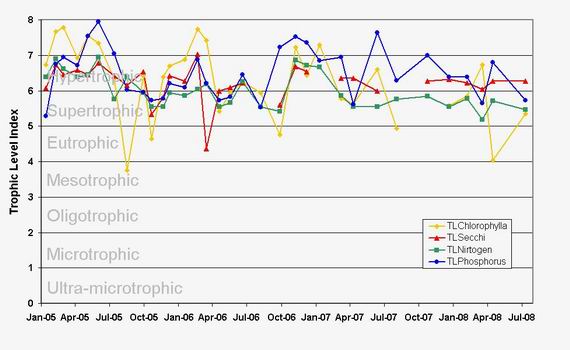
Figure 15: Lake Omapere (eastern site) TLI for chlorophyll a, secchi, total nitrogen, and total phosphorus from January 2005 to July 2008.
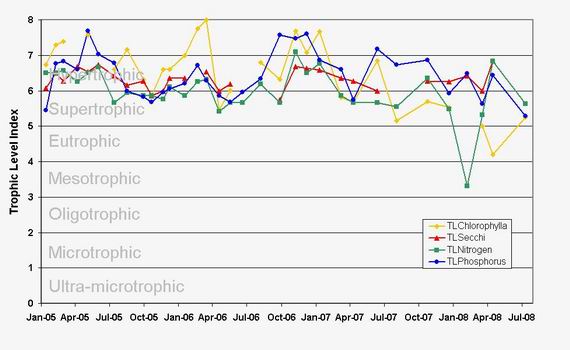
Figure 16: Lake Omapere (western site) TLI for chlorophyll a, secchi, total nitrogen, and total phosphorus from January 2005 to July 2008.
Lake Waiporohita
Lake Waiporohita is situated on the Karikari Peninsula in a pastoral dominated catchment. Results for 2007-08 are summarised in the table below.
| Parameter | Range |
| Temperature (°C) | 12.5 - 20.1 |
| Dissolved Oxygen (mg/L) | 8.5 - 9.8 |
| Dissolved Oxygen (% sat.) | 89.4 - 101.8 |
| Chlorophyll a | 18.1 - 95.7 |
| Conductivity (mSm) | 13.7 - 14.2 |
| Water clarity (m) | 1.04 - 2.5 |
| Dissolved reactive phosphorus (mg/L) | <1 - 28 |
| Total phosphorus (mg/L) | 45 - 159 |
| Ammoniacal nitrogen (mg/L) | 3 - 27 |
| Total nitrogen (mg/L) | 896 - 1490 |
| PH | 6.4 - 7.27 |
Stratification has not been recorded in Lake Waiporohita. Trophic scores for the four parameters appear to be similar for each sampling date. There was an increase in scores in March 2006 and in September 2007. The annual average TLI score was 5.45 suggesting a supertrophic status.
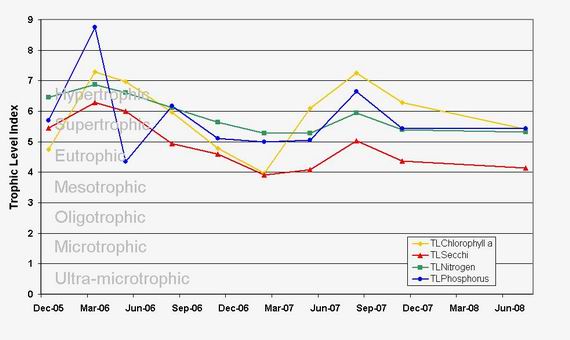
Figure 17: Lake Waiporohita TLI for chlorophyll a, secchi, total nitrogen, and total phosphorus from December 2005 to July 2008.
Kai Iwi Lakes
Lake Kai Iwi
Lake Kai Iwi is 22 hectares in area and is the smallest of the Kai Iwi lake group. The lake margin is bordered by scrub, with pine plantation in the upper catchment. Results for 2007-08 are summarised below.
| Parameter | Range |
| Temperature (°C) | 20.3 – 23.7 |
| Dissolved Oxygen (mg/L) | 8.5 – 9.2 |
| Dissolved Oxygen (% sat.) | 99.9 – 101.5 |
| Chlorophyll a | 1.3 - 3 |
| Conductivity (mSm) | 20 – 30.4 |
| Water clarity (m) | 6.3 – 6.4 |
| Dissolved reactive phosphorus (mg/L) | <1 |
| Total phosphorus (mg/L) | 5 - 6 |
| Ammoniacal nitrogen (mg/L) | 1 - 3 |
| Total nitrogen (mg/L) | 270 - 307 |
| PH | 6.7 – 6.8 |
The lake stratified in summer with deoxygenation (down to 0.2 mg/m3) of bottom water. Total nitrogen and phosphorus concentrations in the bottom waters were higher in late summer (TN 677 mg/m3; TP 30 mg/m3) compared to the upper water column (TN 270 mg/m3; TP 6 mg/m3). The graph below shows that water clarity (secchi) has generally remained within the oligotrophic range and nitrogen in the mesotrophic range, while the other two parameters have varied between levels. Annual average TLI score was 2.89, which indicates an oligotrophic status.
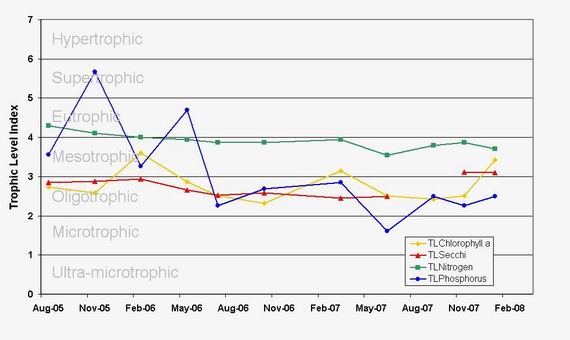
Figure 18: Lake Kai Iwi TLI for chlorophyll a, secchi, total nitrogen, and total phosphorus from August 2005 to February 2008.
Lake Taharoa
Lake Taharoa is Northland's deepest lake with a maximum depth of 38 meters. The catchment is dominated by pine plantation, with areas of scrub. Results for 2007-08 are summarised in the table below.
| Parameter | Range |
| Temperature (°C) | 14 – 22.9 |
| Dissolved Oxygen (mg/L) | 8.5 – 9.9 |
| Dissolved Oxygen (% sat.) | 92.7 – 100.5 |
| Chlorophyll a | 0.5 – 1.3 |
| Conductivity (mSm) | 18.8 – 19.5 |
| Water clarity (m) | 8.8 – 11.5 |
| Dissolved reactive phosphorus (mg/L) | <1 |
| Total phosphorus (mg/L) | 1 – 3 |
| Ammoniacal nitrogen (mg/L) | <1 – 2 |
| Total nitrogen (mg/L) | 129 – 148 |
| PH | 5.9 – 6.3 |
The lake stratified in early summer with moderate deoxygenation of bottom water (down to 0.8 mg/m³). In autumn, nitrogen and phosphorus concentrations were higher in the bottom water column (TN 328 mg/m³; TP 7 mg/m³) than in the upper water column (TN 137 mg/m³; TP 1 mg/m³). All parameters are generally below the mesotrophic range. The average TLI score was 2.14 indicating an oligotrophic status.
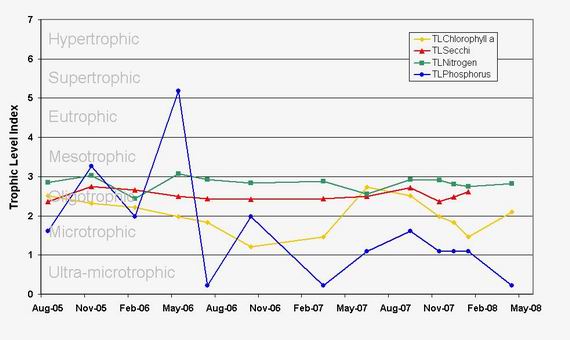
Figure 19: Lake Taharoa TLI for chlorophyll a, secchi, total nitrogen, and total phosphorus from August 2005 to May 2008.
Lake Waikere
Lake Waikere is a relatively large lake (26.5 hectares) which is regularly used for water skiing. The catchment is mainly native scrub, with some pine forestry and pastoral land use. The results for 2007-08 are summarised below.
| Parameter | Range |
| Temperature (°C) | 13.9 – 24.1 |
| Dissolved Oxygen (mg/L) | 8.5 – 9.8 |
| Dissolved Oxygen (% sat.) | 95.3 – 106 |
| Chlorophyll a | 0.8 – 2.2 |
| Conductivity (mSm) | 17.5 – 18.5 |
| Water clarity (m) | 8.6 - 11.4 |
| Dissolved reactive phosphorus (mg/L) | <1 – 1 |
| Total phosphorus (mg/L) | 3 – 15 |
| Ammoniacal nitrogen (mg/L) | <1 – 1 |
| Total nitrogen (mg/L) | 177 – 216 |
| PH | 6.5 - 7 |
The lake stratified over summer with anoxia of bottom water (down to 0.4 mg/m³) and higher concentrations of nitrogen and phosphorus (TN 249 - 278 mg/m³) in relation to the upper water column (TN 177 – 195 mg/m³). A Secchi disk reading of 7.2 indicates good water clarity. Data indicates a mesotrophic status however bottom water nitrogen concentrations are high.
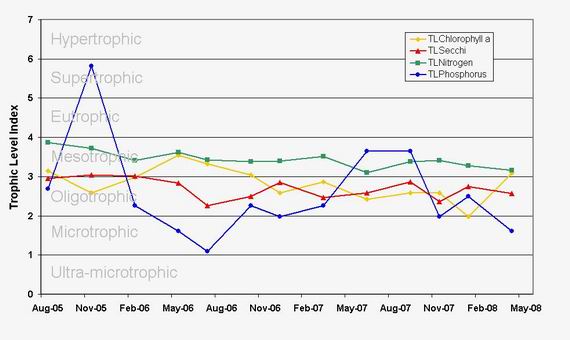
Figure 20: Lake Waikere TLI for chlorophyll a, secchi, total nitrogen, and total phosphorus from August 2005 to May 2008.
Pouto Lakes
Lake Humuhumu
Lake Humuhumu is the deepest Pouto lake, with a maximum depth of 16 metres. The lake is situated in a catchment dominated by pasture, with pine forestry on the western side of the lake. The results from 2007-08 are summarised in the table below.
| Parameter | Range |
| Temperature (°C) | 13.8 - 23 |
| Dissolved Oxygen (mg/L) | 7.9 - 10.2 |
| Dissolved Oxygen (% sat.) | 90.3 - 111.9 |
| Chlorophyll a (mg/L) | 2.3 - 9 |
| Conductivity (mSm) | 20.7 - 21.3 |
| Water clarity (m) | 5.37 - 8 |
| Dissolved reactive phosphorus (mg/L) | <1 |
| Total phosphorus (mg/L) | 13 - 18 |
| Ammoniacal nitrogen (mg/L) | 1.0 - 3.0 |
| Total nitrogen (mg/L) | 257 - 331 |
| PH | 8 - 8.3 |
Summer thermal stratification was observed with deoxygenation of bottom water (0.5 mg/m³) and higher concentrations of nitrogen (TN 826 mg/m³) in relation to the upper water column (TN 290 mg/m³). Most parameters stay within or close to the mesotrophic range. In December 2005 and March 2006, there was a peak in total phosphorus which was seen in most lakes around this time. The annual average TLI score was 3.5 indicating a mesotrophic status.
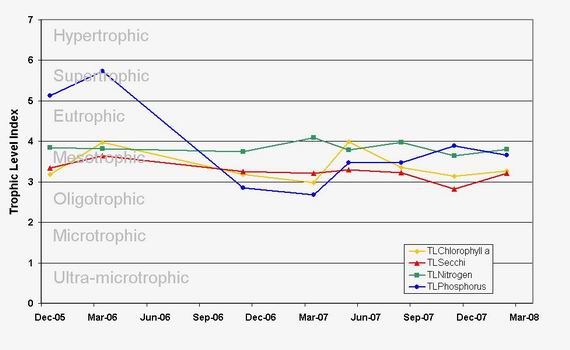
Figure 21: Lake Humuhumu TLI for chlorophyll a, secchi, total nitrogen, and total phosphorus from December 2005 to March 2008.
Lake Kahuparere
This small lake is situated on sand dunes in a pastoral dominated catchment with some forestry and native scrub. Results for 2007-08 are summarised in the table below.
| Parameter | Range |
| Temperature (°C) | 13.5 - 23 |
| Dissolved Oxygen (mg/L) | 7.6 - 11 |
| Dissolved Oxygen (% sat.) | 88.3 - 124.2 |
| Chlorophyll a (mg/L) | 7.7 - 15.1 |
| Conductivity (mSm) | 35.5 - 38.6 |
| Water clarity (m) | 2.4 - 3.87 |
| Dissolved reactive phosphorus (mg/L) | <1 - 2 |
| Total phosphorus (mg/L) | 19 - 48 |
| Ammoniacal nitrogen (mg/L) | 1.0 - 20 |
| Total nitrogen (mg/L) | 411 - 517 |
| PH | 7.8 - 8.6 |
The lake stratified over summer with deoxygenation of bottom water (0.4 – 0.5 mg/m³) and higher concentrations of nitrogen after the second month of stratification (TN 2240 mg/m³) in relation to the upper water column (TN 517 mg/m³). Secchi and total nitrogen measurements varied less over the three year period. The average TLI score for the past year was 4.42 indicating a eutrophic status.
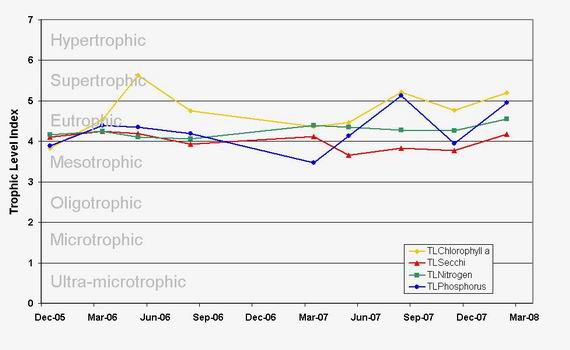
Figure 22: Lake Kahuparere TLI for chlorophyll a, secchi, total nitrogen, and total phosphorus from December 2005 to March 2008.
Lake Kanono
Lake Kanono is a relatively large and deep dune lake located near Pouto Point. The catchment is predominately pastoral and pine forestry. The results from 2007-08 are summarised in the table below.
| Parameter | Range |
| Temperature (°C) | 13.5 - 22.7 |
| Dissolved Oxygen (mg/L) | 7.8 - 11.2 |
| Dissolved Oxygen (% sat.) | 90.4 - 123.5 |
| Chlorophyll a (mg/L) | 4.3 - 28.8 |
| Conductivity (mSm) | 13.3 - 28.7 |
| Water clarity (m) | 1.02 - 2.6 |
| Dissolved reactive phosphorus (mg/L) | <1 - 2 |
| Total phosphorus (mg/L) | 22 - 32 |
| Ammoniacal nitrogen (mg/L) | <1 - 1 |
| Total nitrogen (mg/L) | 314 - 675 |
| PH | 8.4 - 9 |
The lake stratified over summer with deoxygenation of bottom water and slightly higher concentrations of total phosphorus (TP 38 mg/m³) in relation to the upper water column (TP 22 mg/m³). All parameters increased in March to December 2007. The average TLI score for the past year was 4.61 indicating a eutrophic status.
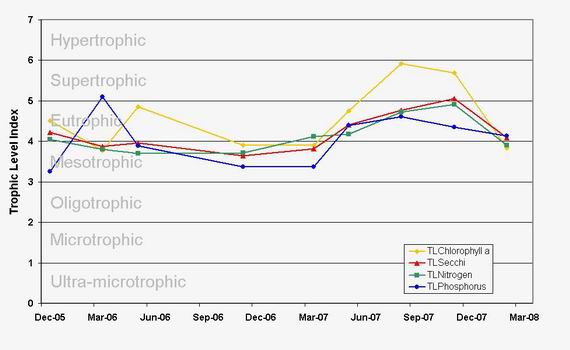
Figure 23: Lake Kanono TLI for chlorophyll a, secchi, total nitrogen, and total phosphorus from December 2005 to March 2008.
Lake Kapoai
Lake Kapoai is located near Te Kopuru, just south of Dargaville, and is 1.6 hectares in area. The catchment is entirely pastoral and the majority of the lake is fenced to prevent livestock access. This lake lacks submerged vegetation. The results for 2007-08 are summarised in the table below.
| Parameter | Range |
| Temperature (°C) | 15.5 - 22.3 |
| Dissolved Oxygen (mg/L) | 7.0 - 10.9 |
| Dissolved Oxygen (% sat.) | 69.9 - 125 |
| Chlorophyll a (mg/L) | 20 - 67.5 |
| Conductivity (mSm) | 35.3 - 36.3 |
| Water clarity (m) | 0.5 - 0.9 |
| Dissolved reactive phosphorus (mg/L) | 5 |
| Total phosphorus (mg/L) | 128 - 130 |
| Ammoniacal nitrogen (mg/L) | 63 - 1420 |
| Total nitrogen (mg/L) | 2160 - 3080 |
| PH | 7.3 - 8.7 |
Summer thermal stratification was observed with deoxygenation of bottom water (down to 0.5 mg/m³) and higher concentrations of nutrients (TN 4740-8960 mg/m³; TP 440-917 mg/m³) in comparison to the upper water column (TN 1310-1980 mg/m³; TP 27-118 mg/m³). Annual average chlorophyll a concentrations and Secchi disk readings (40 mg/m³ and 0.76 m respectively), indicate very low water clarity. Current data indicates a eutrophic to hypertrophic status however bottom water nutrient concentrations are very high.
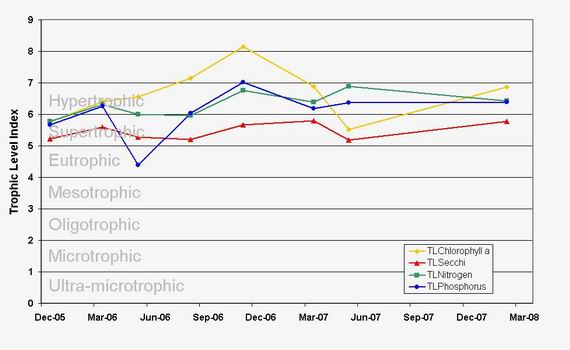
Figure 24: Lake Kapoai TLI for chlorophyll a, secchi, total nitrogen, and total phosphorus from December 2005 to March 2008.
Lake Karaka
Lake Karaka is located near the West Coast on the Pouto Peninsula. Its catchment comprises wetlands, native scrub and pastoral land. The lake is over 11 hectares in size and has a maximum depth of 6 metres. The results from 2007-08 are summarised in the table below.
| Parameter | Range |
| Temperature (°C) | 13.9 - 22.4 |
| Dissolved Oxygen (mg/L) | 8.7 - 9 |
| Dissolved Oxygen (% sat.) | 87.7 - 98.8 |
| Chlorophyll a (mg/L) | 1.5 - 4.1 |
| Conductivity (mSm) | 27.9 - 31.5 |
| Water clarity (m) | 2.05 - 5.58 |
| Dissolved reactive phosphorus (mg/L) | 0.001 - 0.003 |
| Total phosphorus (mg/L) | 0.018 - 0.03 |
| Ammoniacal nitrogen (mg/L) | 0.006 - 0.09 |
| Total nitrogen (mg/L) | 0.305 - 0.405 |
| PH | 7.7 - 7.8 |
The lake was not stratified at the time of sampling however stratification of the lake has been recorded previously. The annual average Secchi disk reading of 2.97 m indicates moderate water clarity. Secchi, nutrient and chlorophyll a measurements (TN 257-536 mg/m³; TP 40-64 mg/m³; chlorophyll a 4.5-51 mg/m³) currently indicate a eutrophic status.
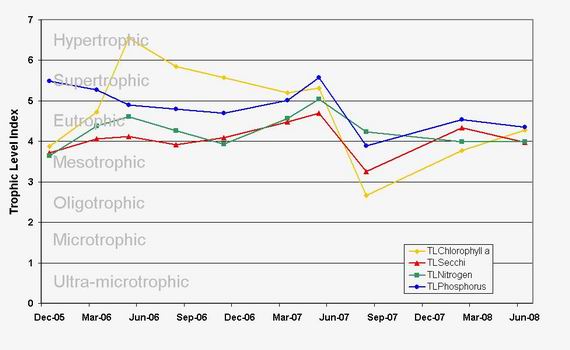
Figure 25: Lake Karaka TLI for chlorophyll a, secchi, total nitrogen, and total phosphorus from December 2005 to March 2008.
Lake Mokeno
Lake Mokeno is 148 hectares in size making it the largest Pouto Lake. This lake is located near the West Coast and is entirely surrounded by native scrub and wetlands, with pine forestry in the upper catchment. Water from this lake flows south through extensive wetlands until it reaches the Kaipara Harbour. Results for 2007-08 are summarised in the table below.
| Parameter | Range |
| Temperature (°C) | 11.8 - 21.9 |
| Dissolved Oxygen (mg/L) | 8.7 - 10 |
| Dissolved Oxygen (% sat.) | 89.8 - 103.8 |
| Chlorophyll a (mg/L) | 1.4 - 4 |
| Conductivity (mSm) | 24.3 - 28.7 |
| Water clarity (m) | 2.58 - 5.9 |
| Dissolved reactive phosphorus (mg/L) | <1 - 4 |
| Total phosphorus (mg/L) | 15 - 24 |
| Ammoniacal nitrogen (mg/L) | 3 - 15 |
| Total nitrogen (mg/L) | 395 - 564 |
| PH | 7.4 - 7.9 |
Stratification was not detected during 2007-08 however stratification has previously been recorded in this lake. An annual average Secchi disk reading of 3.17 indicates moderate water clarity. Secchi, nutrient and algal biomass data (TN 450-606 mg/m³; TP 13-87 mg/m³; chlorophyll a 2.1-7.2 mg/m³) currently indicate a eutrophic status.
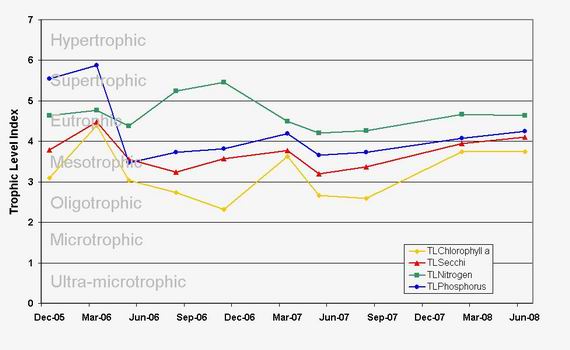
Figure 26: Lake Mokeno TLI for chlorophyll a, secchi, total nitrogen, and total phosphorus from December 2005 to March 2008.
Lake Rotokawau
Lake Rotokawau is set in a pastoral catchment and is 26.4 hectares in size. The lake is completely fenced and is bordered by pine forestry. Results from 2007-08 are summarised below.
| Parameter | Range |
| Temperature (°C) | 17.4 – 23 |
| Dissolved Oxygen (mg/L) | 8.1 - 9.2 |
| Dissolved Oxygen (% sat.) | 94.3 - 96.6 |
| Chlorophyll a (mg/L) | 1.8 - 2.8 |
| Conductivity (mSm) | 13.7 - 14.2 |
| Water clarity (m) | 7.05 |
| Dissolved reactive phosphorus (mg/L) | <1 |
| Total phosphorus (mg/L) | 10 – 11 |
| Ammoniacal nitrogen (mg/L) | 3 – 21 |
| Total nitrogen (mg/L) | 310 – 336 |
| PH | 6.7 |
Summer thermal stratification was not detected during 2007-08 however stratification has previously been recorded in this lake. Current Secchi, nutrient and chlorophyll a measurements (Secchi 4.3-5.13 m; TN 363-374 mg/m³; TP 5-26 mg/m³; chlorophyll a 2.6-3.8 mg/m³) indicate a mesotrophic status.
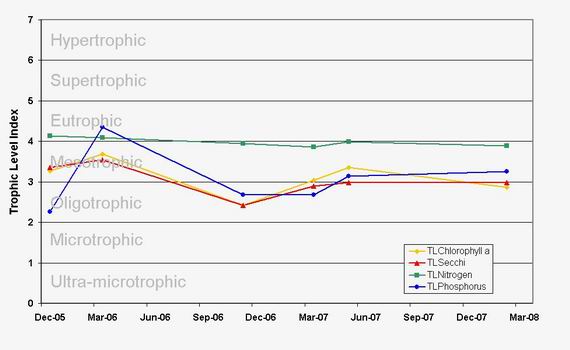
Figure 27: Lake Rotokawau TLI for chlorophyll a, secchi, total nitrogen, and total phosphorus from December 2005 to March 2008.
Lake Rototuna
This small dune lake is located mid-way down the Pouto Peninsula and is easily accessible from the main road. The lake is fenced and lake margins have been planted with native wetland species. The results for 2007-08 are summarised below.
| Parameter | Range |
| Temperature (°C) | 14.5 - 20.1 |
| Dissolved Oxygen (mg/L) | 8.3 - 10.8 |
| Dissolved Oxygen (% sat.) | 92.5 - 119.4 |
| Chlorophyll a (mg/L) | 6.8 - 12.9 |
| Conductivity (mSm) | 17.6 - 19.1 |
| Water clarity (m) | 2.23 - 3.7 |
| Dissolved reactive phosphorus (mg/L) | <1 - 1 |
| Total phosphorus (mg/L) | 19 - 30 |
| Ammoniacal nitrogen (mg/L) | 3 - 4 |
| Total nitrogen (mg/L) | 523 - 601 |
| PH | 7.7 - 9.1 |
The lake stratified over summer with moderate deoxygenation of bottom water (0.8 mg/m³) and higher concentrations of nutrients (TN 998 mg/m³; TP 83 mg/m³) in relation to the upper water column (TN 508-607 mg/m³; TP 8-44 mg/m³). The annual average Secchi disk reading of 2m indicates low water clarity. The data indicates a eutrophic status however bottom water nutrient concentrations are higher.
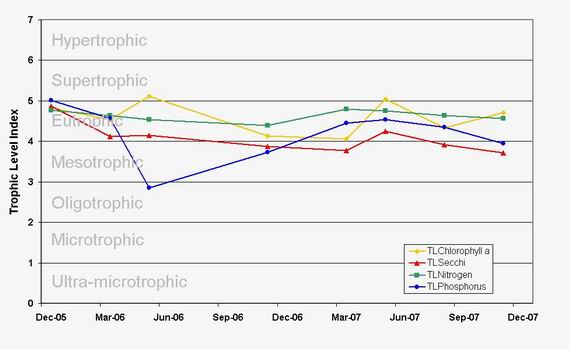
Figure 28: Lake Rototuna TLI for chlorophyll a, secchi, total nitrogen, and total phosphorus from December 2005 to March 2008.
Lake Wainui
Lake Wainui is a small dune lake that is surrounded by pastoral land, with cattle grazing to the lake edge. The lake lacks emergent vegetation in areas easily accessible to the cattle. The results from 2007-08 are summarised in the table below.
| Parameter | Range |
| Temperature (°C) | 15.9 - 21.7 |
| Dissolved Oxygen (mg/L) | 8.5 - 10.9 |
| Dissolved Oxygen (% sat.) | 88.9 - 122.6 |
| Chlorophyll a (mg/L) | 5.5 - 33.6 |
| Conductivity (mSm) | 44.1 - 46.2 |
| Water clarity (m) | 1.24 - 2.5 |
| Dissolved reactive phosphorus (mg/L) | <1 - 2 |
| Total phosphorus (mg/L) | 35 - 61 |
| Ammoniacal nitrogen (mg/L) | 2 - 8 |
| Total nitrogen (mg/L) | 503 - 784 |
| PH | 7.2 - 8.8 |
The lake stratified over summer with moderate deoxygenation of bottom water (down to 0.5 mg/m³) and higher concentrations of nutrients (TN 1570-3060 mg/m³; TP 213-476 mg/m³) in relation to the upper water column (TN 593-725 mg/m³; TP 13-94 mg/m³). Current data suggests a eutrophic to hypertrophic status however bottom water concentrations of nitrogen and phosphorus are very high.
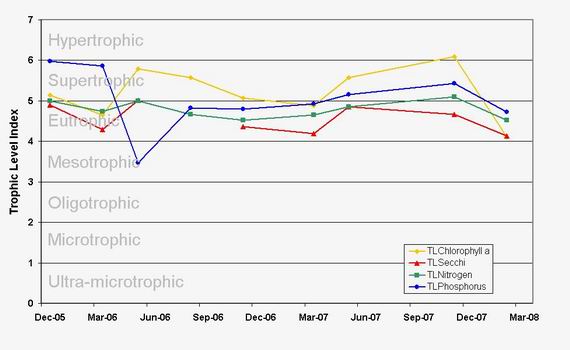
Figure 29: Lake Wainui TLI for chlorophyll a, secchi, total nitrogen, and total phosphorus from December 2005 to March 2008.
Lake Whakaneke
Lake Whakaneke is located south of Lake Mokeno at the bottom of the Pouto Peninsula. This shallow dune lake is surrounded by manuka scrub and wetlands. The results from 2007-08 are summarised below.
| Parameter | Range |
| Temperature (°C) | 13.5 - 17 |
| Dissolved Oxygen (mg/L) | 7.2 - 10.8 |
| Dissolved Oxygen (% sat.) | 68.9 - 112.3 |
| Chlorophyll a (mg/L) | 4.1 - 139 |
| Conductivity (mSm) | 35.3 |
| Water clarity (m) | 0.48 - 1.36 |
| Dissolved reactive phosphorus (mg/L) | 5 - 12 |
| Total phosphorus (mg/L) | 59 - 239 |
| Ammoniacal nitrogen (mg/L) | 2 - 31 |
| Total nitrogen (mg/L) | 563 - 1780 |
| PH | 7.5 - 8.9 |
Stratification has not been detected in this lake. A seasonal pattern is quite obvious in the graph below for all four parameters used in calculating the TLI. Over the summer months, chlorophyll a and total phosphorus levels are well above the hypertrophic status whereas Secchi measurements and total nitrogen levels stay within the supertrophic and hypertrophic limits. From May to September 2007, the average TLI score was 6.24 indicating a hypertrophic status.
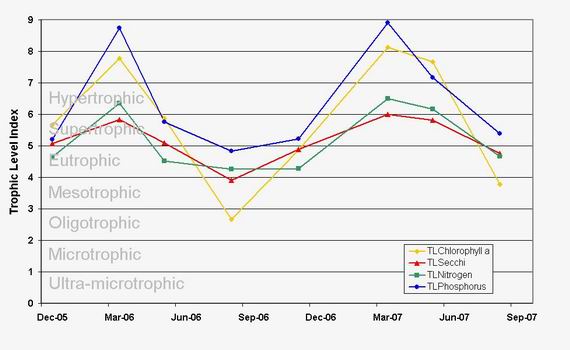
Figure 30: Lake Whakaneke TLI for chlorophyll a, secchi, total nitrogen, and total phosphorus from December 2005 to September 2007.
Lake Water Quality Summary
Water quality data for the 31 lakes monitored shows that 53% are mesotrophic or oligotrophic (low in nutrients), whereas 47% can be graded as eutrophic or worse (see graph below). Lakes graded as eutrophic or worse have high nutrient and algal levels and low water clarity. Eutrophic lakes are generally set in pastoral catchments and lack emergent vegetation. Examples include Lakes Omapere (Central), Rotoroa (Aupouri) and Wainui (Pouto). By comparison, lakes graded as oligotrophic, for example, Lakes Te Kahika (Aupouri), Taharoa and Waikere (Kai Iwi), are set in forested catchments and have emergent vegetation.
